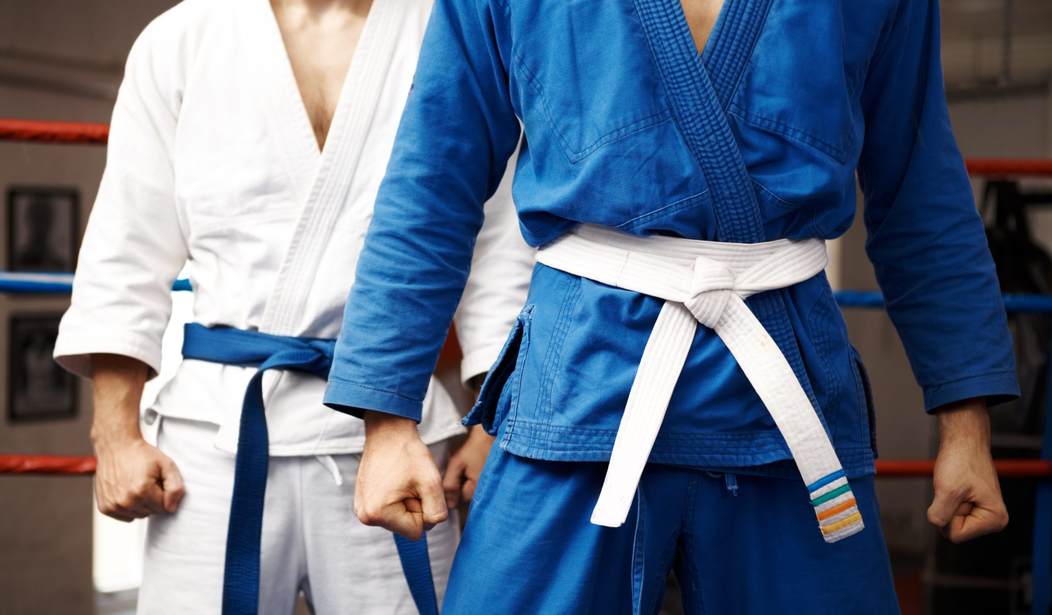Nothing should take the place of your regular training in your martial arts school, but… life happens. I admit that I am a fanatic: I train seven days a week. Six days I do a one-hour session, and one day a week I devote to just reading a martial arts book or watching a video. I have those weeks, however, when my desires do not match up with the time I actually have due to my jobs, family obligations, interruptions, etc.
So how can a busy martial artist still fit in some training when a full hour that day just isn’t possible? How about 15 minutes that day? Can you fit in just a quick 15-minute session? I’ve done this, and it has helped me in those weeks when I am just slammed due to a hectic schedule. Here are a few ideas that maybe you can put to good use “when life hits.”
1. Work on striking.
You only have 15 minutes, so you cannot practice a wide variety of skills. Since self-defense is a priority with me (and most martial artists), I want to work on those techniques that I can deploy the fastest to save my life — like striking. In striking, I specifically mean all the empty-hand strikes (palm heel, knife hand, Y-hand) as well as punches and elbow strikes. I will warm up for maybe just a minute with the jump rope, then slowly work through my self-defense combinations on the heavy bag with palm-heel strikes, elbows, and punches.
I normally do not work on anything “fancy,” such as spinning techniques, since I probably will not use such things in a life-or-death situation. Five minutes into the workout, I speed up to do combinations as quickly as I can. By the time 15 minutes are up, I am sweating, gasping for air, and feeling pretty good that at least I got in some training that day.
It is not necessary to have a heavy bag, however. Shadowboxing is wonderful, and there are numerous agility drills you can do to help with your reflexes. You can also do your striking while holding very light weights or with a weighted vest strapped on. This will certainly help with power and speed.
Shane Fazen from FightTips runs through a fun drill to help with speed in your punching:
Shane also demonstrates a really good 3-minute conditioning drill you can do by yourself. This drill will definitely give you a good workout as well as improve your skills:
2. Kicking.
No time to stretch? Since you only have 15 minutes, work only on the low-line “grunt” kicks that will save your life (I include knee strikes in this category).
I generally spend the first five minutes slowly doing the mechanics of a front kick (or a side kick or a roundhouse kick) to the leg. I will then speed up my kicks and kick full force into the target (a low-hanging heavy bag or a pile of judo mats standing up on their side). I concentrate on accuracy first, then power.
In a self-defense situation, I might be able to get off one good solid kick to my opponent’s legs, so it has to be able to cripple the attacker. Keep the heavy bag swinging to make sure that you can hit a moving target with accuracy and power.
Don’t feel like kicking that day? That is just fine. Just spend those 15 minutes stretching. You don’t have to always do something that is “pure combat training,” and some days you are just low on energy. On those days I do a lot of stretching, and I feel great afterwards.
Jesse Enkamp gives some insight on how to train in low kicks (you can easily pare this down to a 15-minute session):
Alex Wong teaches some drills from the spectacular kicks of taekwondo (it would take me a lot of stretching to do these kicks at my “old age” of 56). If you are pretty flexible already you may be able to fit some of these techniques into your brief workout:
3. Grappling.
Well, this is going to be more difficult since the grappling arts (wrestling, judo, jiu-jitsu, sambo) require an opponent in order to practice the throws, sweeps, joint locks, and chokes that are necessary to get an opponent to submit. However, when I took judo (a very long time ago) we did do plenty of solo drills, and I know that the other arts have similar drills. In your very limited time, you must make do with what you have.
I know that the best thing is to have an actual opponent to work with. Absent a partner, a grappling dummy can still help.
When I am by myself, I still practice my throws, sweeps, and joint locks by going through the movements. It may look like I am “playing an air guitar” to some people, and it may not be very aerobic, but even that amount of additional training still keeps me refreshed in the little bit of grappling arts that I know.
The renowned jiu-jitsu artist Stephan Kesting (along with Shane Fazen in this video) demonstrates some very good ideas about solo training for the grappling arts:
Here are other good solo training ideas, this time with a heavy bag:
4. Self-defense drills.
This is where I put it all together. The optimal way to practice is with a partner for an hour, of course. However, life does not always cooperate. So, in the 15 spare minutes I have, I use my imagination.
I imagine an opponent attacking me in a variety of ways, and I slowly work my way through that scenario with strikes, kicks, throws, or joint locks (whatever I think is appropriate at that time). Sometimes I will work in low light. Sometimes I will work in cramped spaces. Maybe I will strap on a weighted vest; other times I will start from the ground and imagine an attacker trying to do some “ground and pound” on me.
How many drills can I work through in just 15 minutes? Quite a few, it turns out. About half-way through, I will speed up my techniques so that I can perform them without even thinking about it.
Nick Drossos talks about imagining real scenarios in self-defense training in this video:
For my friends who are into the more traditional martial arts such as kung fu, taekwondo, and karate, I suggest doing forms (“kata” or “poomsae”) while truly imagining an actual attacker in front of you. Think through the “bunkai” (practical application) of each move.
Master Patrick McCarthy explains practical application in kata to Jesse Enkamp:
I would also emphasize working with weapons. Although some of the traditional martial arts weapons (nunchaku, sai) are not that practical for the 21st century, some still are. I greatly value the training I have had in the bo (staff) and tonfa (side handle baton). With my bo training I can use a mop handle very effectively against an attacker. If you are good in working escrima sticks, you definitely are skilled in using a weapon that can be readily acquired in a self-defense situation. I am sure you can do many good drills with your weapons of choice in 15 minutes.
It’s always best to have a trained partner. It’s always better to train for an hour under the tutelage of a expert instructor. But in the absence of such things, and in the middle of a hectic week when things don’t work out, hopefully you can still fit in just a few minutes a day to keep your martial skills sharp.









Join the conversation as a VIP Member